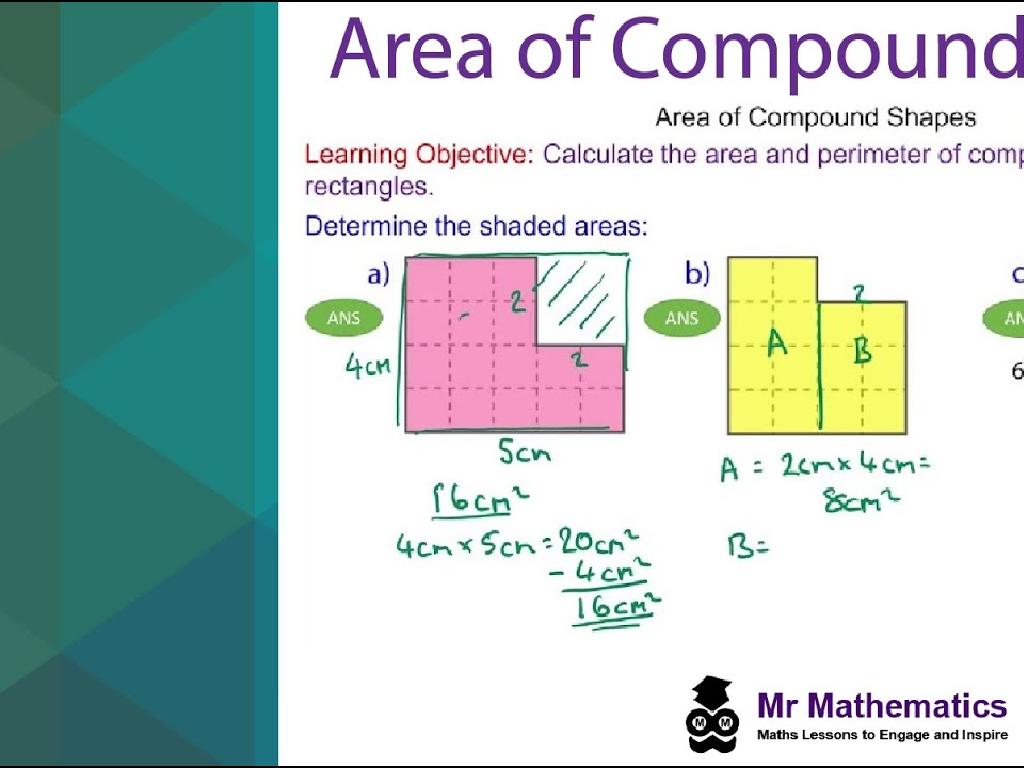Interpret Measures Of Center And Variability
Subject: Math
Grade: Sixth grade
Topic: Statistics
Please LOG IN to download the presentation. Access is available to registered users only.
View More Content
Understanding Statistics: Center & Variability
– What are measures of center?
– Mean, median, and mode are measures of center
– What is variability in data?
– Variability shows how spread out data is
– Importance of statistics in life
– Helps us make informed decisions
– Statistics in the real world
– Used in weather forecasts, sports, and more
|
This slide introduces students to the fundamental concepts of statistics, focusing on measures of center and variability. Measures of center, including mean, median, and mode, are ways to determine the central point of a data set. Variability describes the spread of data points. Emphasize the importance of statistics in everyday life, such as in making informed decisions based on data. Provide relatable examples, like how statistics are used to predict weather patterns, analyze sports team performance, or in research studies. Encourage students to think of other areas where statistics play a role. This will help them understand the relevance and application of statistics beyond the classroom.
Understanding the ‘Center’ in Statistics
– ‘Center’ indicates typical data value
– Three measures: Mean, Median, Mode
– Mean adds all numbers, then divides by count
– Mean: Average of all numbers
– Median: Arrange numbers, find the center one
– Median: Middle value in order
– Mode: Most frequently occurring number
|
The concept of ‘center’ in statistics is crucial for understanding data sets. It helps us find the typical or average value that represents a set of numbers. The mean is calculated by adding all the numbers together and dividing by the total count of numbers. The median is found by arranging the numbers in order and selecting the middle one. If there is an even number of data points, the median is the average of the two middle numbers. The mode is simply the number that appears most frequently. These measures of center are foundational in statistics and are used to summarize and analyze data. Encourage students to practice calculating each measure with different data sets to understand how they can sometimes give different perspectives on the same set of numbers.
Exploring the Mean
– Calculating the mean
– Add all numbers together, then divide by the number of numbers.
– Example: Mean of a number set
– If we have 3, 5, 8, 10, the mean is (3+5+8+10)/4 = 6.5.
– Class Exercise: Find your mean
– Use a set of numbers from your daily life, like ages or scores.
|
The mean, often referred to as the average, is a measure of center in statistics. It is calculated by adding all the numbers in a set and then dividing by the count of numbers. Start with an example set of numbers to demonstrate the calculation. For the class exercise, encourage students to think of a set of numbers that are relevant to them, such as the ages of family members or points scored in games. Provide detailed guidelines for the teacher to facilitate the activity, suggesting that students can use calculators for addition and division, and to ensure they understand the concept of the mean as a representation of the ‘center’ of their data set.
Finding the Median
– Steps to determine the median
– List numbers, order them, find middle value
– Example: Ordering numbers to find median
– For 3, 9, 5, 7, 2: Order is 2, 3, 5, 7, 9. Median is 5.
– Class Exercise: Calculate your median
– Use a set of numbers to practice finding the median.
|
This slide introduces the concept of the median as a measure of center in a data set. Start by explaining the steps to find the median: listing all numbers, ordering them from smallest to largest, and finding the number in the middle. If there is an even number of data points, the median is the average of the two middle numbers. Provide an example with an odd number of data points, such as 3, 9, 5, 7, 2, and walk through the steps to find the median. For the class exercise, allow students to choose their own set of numbers or provide them with a data set to calculate the median. This activity will help solidify their understanding of how to find the median and why it’s a useful measure of center. Encourage students to explain their process and reasoning during the exercise.
Identifying the Mode in a Data Set
– Understanding the mode
– The mode is the most frequently occurring number in a set.
– Mode identification example
– For the set 2, 3, 3, 5, 7, the mode is 3.
– Class exercise: Find the mode
– Use a set of numbers to practice finding the mode.
|
This slide introduces the concept of the mode as a measure of center in a data set. The mode is the value that appears most frequently in a set of numbers. Start with an example to show how to identify the mode by finding the number that occurs most often. Then, move on to a class exercise where students will find the mode of a set of numbers they’ve been given or have collected themselves. This activity will help solidify their understanding of the mode and how it can be used to summarize data. Provide guidance on how to handle data sets with no mode or multiple modes, and encourage students to explain their reasoning during the exercise.
Understanding Variability in Data
– Variability in data explained
– Variability shows the spread of data points.
– Range: Data’s high-low difference
– Subtract the smallest value from the largest.
– Variance: Data’s spread measure
– Variance quantifies how much the numbers differ from the mean.
– Standard Deviation: Spread precision
– Standard Deviation is the square root of variance, indicating how much data varies from the average.
|
This slide introduces the concept of variability, which is crucial for understanding how data points in a set are distributed. Variability can be described using several statistics, including range, variance, and standard deviation. Range is the simplest measure, calculated by subtracting the lowest value from the highest. Variance and standard deviation provide more detail about the spread of data around the mean. Variance is the average of the squared differences from the mean, while standard deviation is the square root of variance, offering a measure that is in the same units as the data. Encourage students to practice calculating these measures with real datasets to grasp the concepts fully.
Understanding Range in Statistics
– Definition of range
– Range is the difference between the highest and lowest values in a data set.
– Steps to calculate range
– To find range: Subtract the smallest number from the largest number in the set.
– Example: Data set range
– If a set is 4, 7, 13, 15, the range is 15 – 4 = 11.
– Class exercise: Find your range
|
This slide introduces the concept of range as a measure of variability in a data set. Begin by defining range and discussing its importance in understanding how spread out the numbers in a data set are. Walk through the steps of calculating range using subtraction. Provide an example with a simple data set to illustrate the concept. For the class exercise, have students collect their own data set, perhaps the number of books each student has read this month, and calculate the range. This will help them apply the concept of range to a real-world scenario and understand variability within their own data.
Variance and Standard Deviation
– Formulas for variance and standard deviation
– Variance (ò) measures how much data points differ from the mean. Standard deviation (Ã) is the square root of variance.
– Significance of these measures
– They show us the spread of a data set and how much it varies from the average.
– Example: Calculating variance and standard deviation
– Given data set: 3, 7, 7, 2, 9, calculate ò and Ã.
– Interpreting the results
– A small à indicates data is close to the mean, while a large à shows more variability.
|
This slide introduces students to the concepts of variance and standard deviation, which are statistical tools used to measure the spread of a data set. Variance is the average of the squared differences from the Mean, and standard deviation is the square root of variance, providing a measure of how spread out numbers are. It’s crucial for students to understand that these measures give us insight into the consistency of data. For example, in a set of test scores, a low standard deviation means most students scored similarly, while a high standard deviation indicates scores were more varied. Use the provided example to walk through the calculation process step by step, ensuring students grasp the method and can interpret the results in terms of data spread.
Class Activity: Statistics in Action!
– Collect height data in groups
– Calculate mean, median, mode
– Find range and standard deviation
– Discuss measures’ significance
– How do these statistics give us insights about our class’s height distribution?
|
This interactive group activity is designed to help students apply statistical concepts to real-world data. Divide the class into small groups and have each group measure and record the height of each student. Then, guide them to calculate the mean, median, mode, range, and standard deviation of their collected data. After the calculations, lead a class discussion on how these measures of center and variability provide a deeper understanding of the class’s height distribution. For example, the mean gives the average height, the median provides the middle value, and the mode reflects the most common height. The range shows the spread of heights, and the standard deviation indicates how much the heights vary from the average. This activity will help students grasp the practical application of statistics.
Conclusion: Understanding Data with Statistics
– Recap: Centers and Variability
– Measures of center: mean, median, mode. Variability: range, IQR, standard deviation.
– Statistics: Why They Matter
– Statistics help us make sense of data and inform decisions.
– Your Questions Answered
– Clarifying Your Doubts
|
As we wrap up today’s lesson on statistics, remember that measures of center and variability are tools that help us summarize and understand data. The mean, median, and mode give us a sense of the ‘middle’ of our data, while range, interquartile range (IQR), and standard deviation tell us about the spread of our data. Understanding these concepts is crucial because they allow us to analyze real-world data effectively, supporting decision-making in various fields such as science, economics, and more. Now, let’s open the floor for any questions you might have. Don’t hesitate to ask for clarifications or further examples this is your time to clear up any uncertainties you may have about today’s material.





